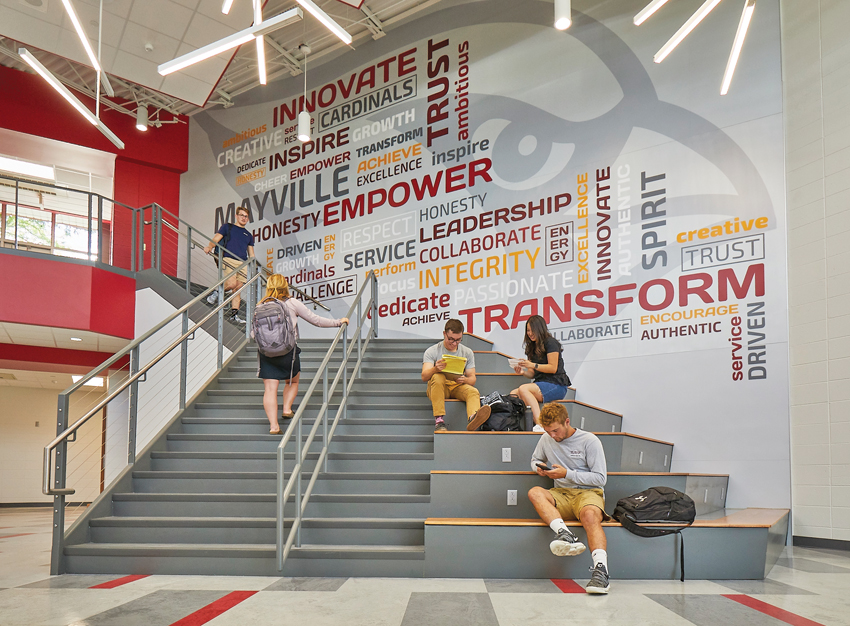Public Health and Sustainability Concerns in Schools
Durable, Clean Surfaces
It is clear that the threat of virus transmission via airborne aerosols or particles has been a primary focus of the means to protect people from infection. In addition to direct airborne transfer, however, the AIA report has also identified the risk of “virus transmission through contact of shared surfaces.” Since airborne particles could land on any surface or since infected people could touch or sneeze and cough anywhere, it makes sense that the AIA report recommends that “all contact surfaces should be considered.”
What does this mean as a practical matter? The report recommends “implementing increased cleaning and maintenance protocols to reduce virus transmission. Building facility staff should frequently disinfect all high-touch spaces, surfaces, hardware, furnishings, and classroom tools, at a minimum, per CDC guidelines.” While this may sound like it is purely an operational concern, the reality is that it is also a design concern.
If the surface materials used in schools are not easily cleaned, this is a problem since they could become sites of virus transfer. On the other hand, if the surfaces can be cleaned but are not durable enough to handle the repeated cleaning without fading, wearing, or otherwise degrading prematurely, this needs to be addressed as well. Of course, schools are busy places with a lot of people and equipment moving daily. This means the interior finishes can readily get rubbed, bumped, banged, or even abused and start to show signs of wear quickly. If these interior surfaces become physically damaged, they can become problem spots that are not only difficult to clean but could also be prime locations for germs and bacteria to collect and build up, ready to be transferred to the next person who touches or brushes by them.
In light of the above considerations, the addition of durable, cleanable, protective interior surface treatments has become a significant consideration. Some of the options and choices are discussed as follows.

Photos courtesy of Inpro
Protective wall coverings can be designed into schools using a variety of materials, finishes, and details that provide durable solutions that are easy to clean and inhibit the spread of disease.
Interior Wall Protection
Interior walls are at the forefront of the need for durability in a school. Corners, edges, and other aspects of an interior design are subject to wear and tear from moving people or equipment. Therefore, adding products specifically designed to protect these areas is common and makes sense for many school situations. The best approach is referred to as targeted wall protection, where a specific set of products is used that is designed to absorb impact and protect the underlying portion of the wall. By targeting the most vulnerable areas, protection can be added by using corner-guard or wall-guard products specifically where they are needed. These can include horizontal rails across targeted sections of the walls as well as vertically installed corner guards. Since many of these products can be specified with materials that are not only durable but also easy to clean, they help protect the building as well as the people in them.
Taking the concept of wall protection further, sheets of rigid wall covering have been used where large surfaces need to be made more durable and easier to clean. Usually produced in sheets or rolls, rigid vinyl extruded wall cladding comes in several standard thicknesses. For medium-duty installations, 0.028 is used when flexibility is needed, such as wrapping a column. A slightly heavier 0.040 can be used to eliminate re-painting where repeated scuffing wears through the top layer of drywall. For heavier-duty locations, 0.060 is used to protect against gouging of the wall, while 0.080 is used for maximum protection, often installed on top of cement board or fire-rated plywood. Most of these products offered in the United States are Class A fire rated with many choices of product types, finishes, and colors to enhance, rather than detract from, an interior design scheme.
For wall areas that need specialized protection, there are also some specialized choices. These include hygienic wall cladding that is ideally suited for kitchen or laboratory spaces. Coupled with stainless-steel corner guards and wall base, this provides a very durable and cleanable surface that is designed to inhibit growth of organic substances. There are also solid-surface wall claddings that are nonporous, long lasting, easily repairable, and available in many different colors. By working with manufacturers of wall cladding and targeted protection systems, the best solutions can be determined for different locations within schools. Adding this material to new or existing facilities can not only enhance interior designs, but it can also help them stay cleaner and more resistant to wear over time.

Photo courtesy of Inpro
Printed wall-protection systems can be used in schools for education programs, social distancing, wayfinding, or to promote school spirit, all while helping to keep walls clean and durable.
Notice

www.inpro.com

www.mitsubishipro.com

www.nanawall.com

www.newmill.com/gallery










